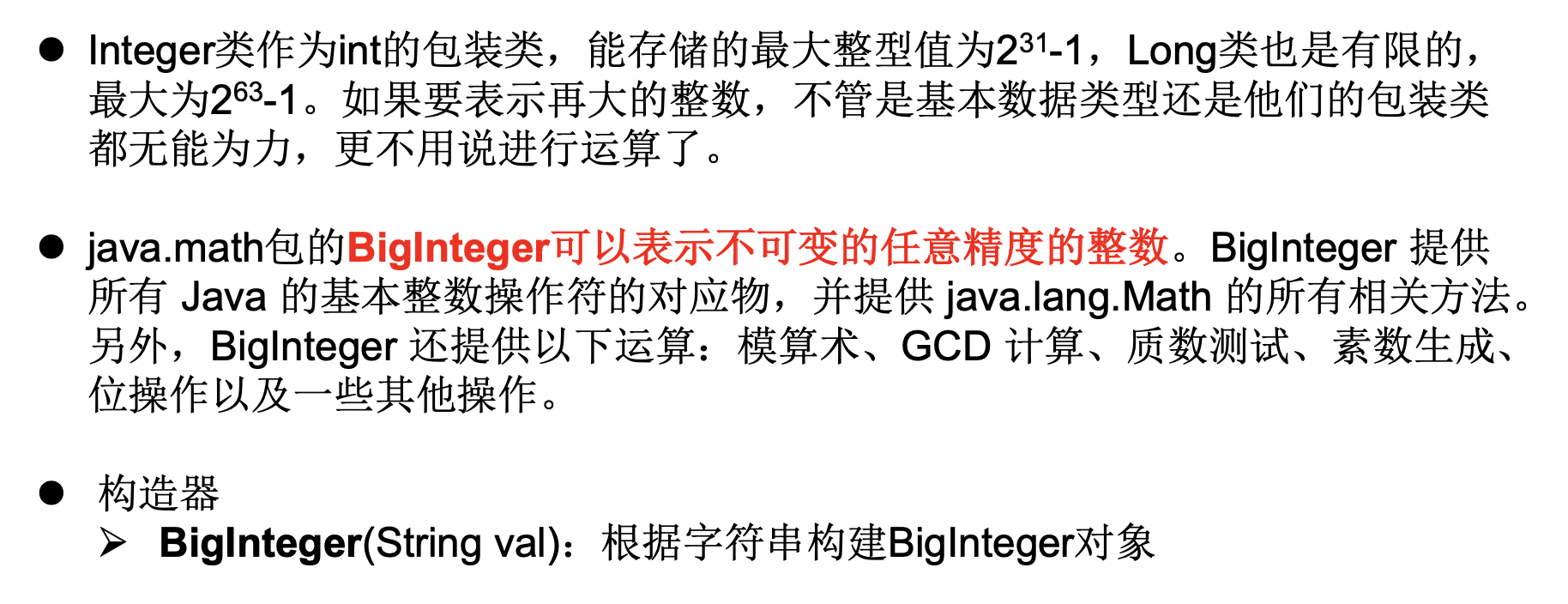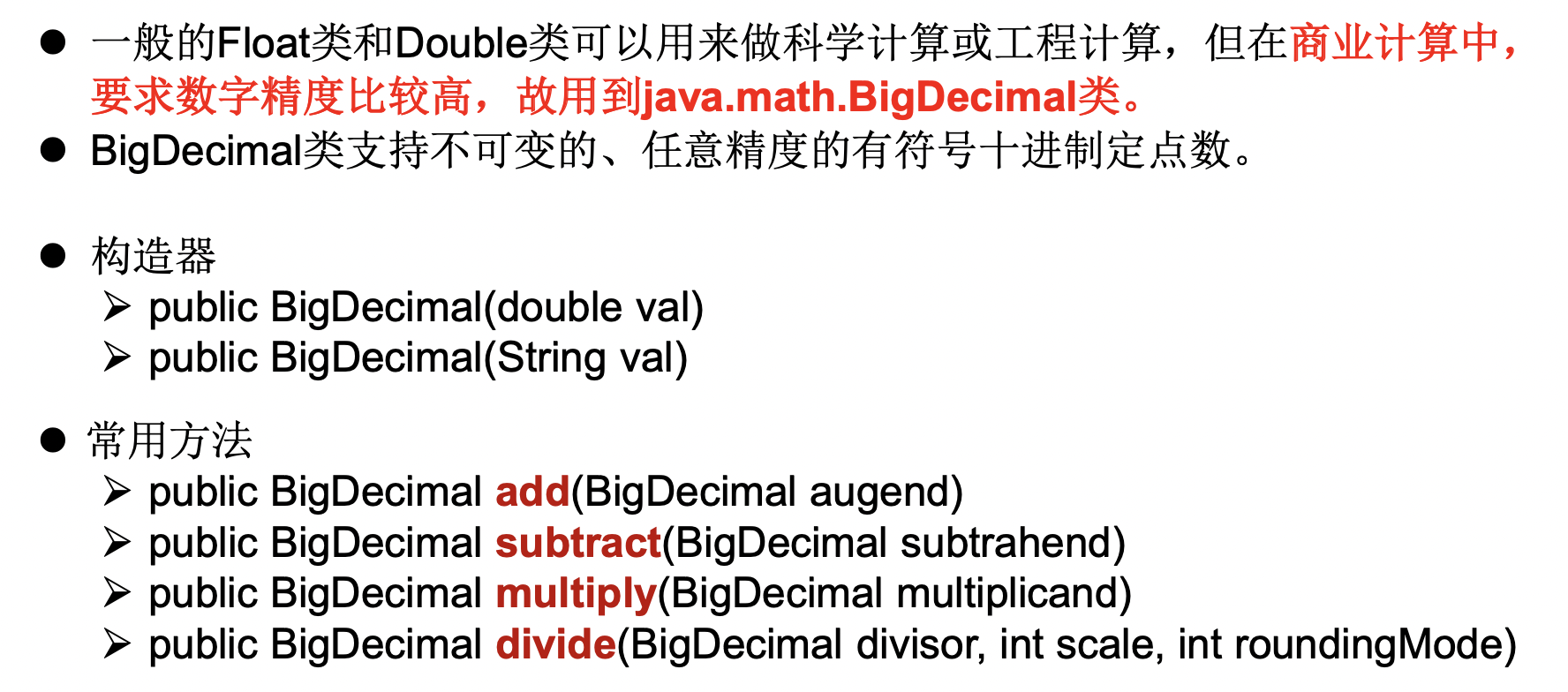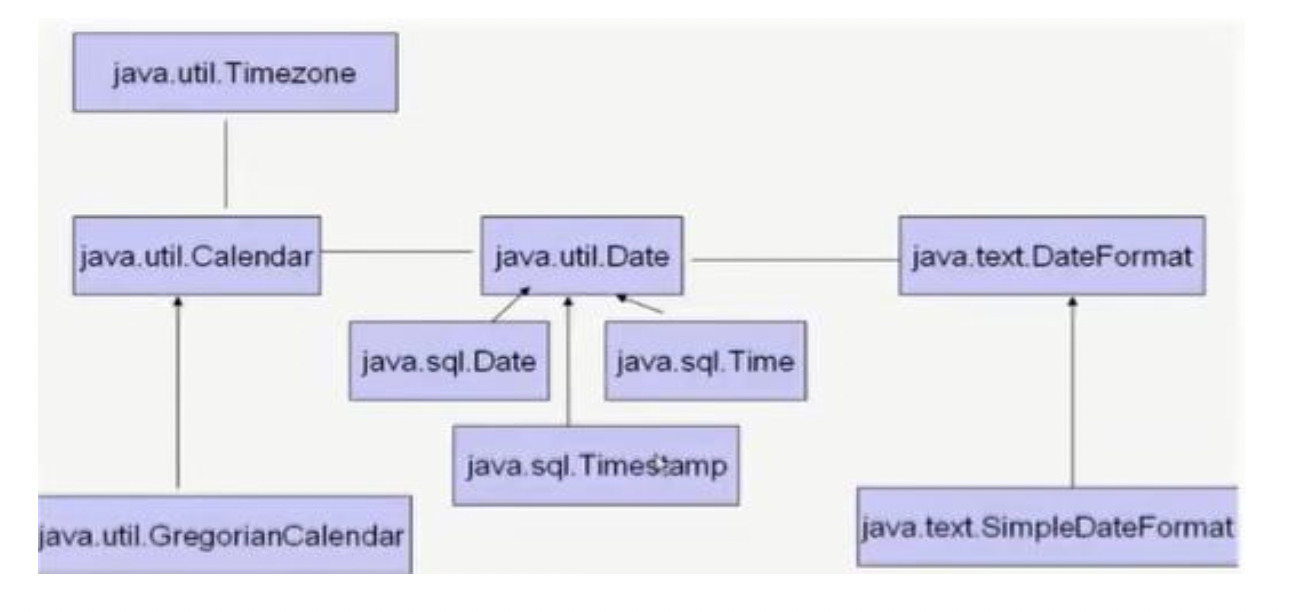字符串相关的类
String 类
String表示字符串,使用一对""引起来表示,有以下几个特点:
1、实现了Serializable接口,表示字符串是支持序列化的。
2、实现了Comparable接口,表示可以比较大小。
3、内部定义了final char[] value的数组用于存储字符串数据。
4、String类的实例化有2种方式:
- 通过字面量定义的方式,比如
String s1 = "abc",此时的字符串数据值保存在常量池中,栈中变量s1保存的是其地址值。 - 通过
new的方式,比如String s2 = new String("abc");,此时的字符串数据值保存在常量池中,堆空间中new出来的对象保存的是其地址值,栈中变量s2保存的是对象的地址。
5、String类声明为final,表示不可被继承,代表不可变的字符序列。
- 当对字符串重新赋值时,需要重写指定内存区域赋值,不能使用原有的
value进行赋值。 - 当对现有的字符串进行连接操作时,也需要重新指定内存区域赋值,不能使用原有的
value进行赋值。 - 当调用
String的replace()方法修改指定字符或字符串时,也需要重新指定内存区域赋值,不能使用原有的value进行赋值。
6、String类使用细节:
- 常量与常量的拼接结果在常量池中,且常量池中不会存在相同内容的常量。
- 只要其中有一个是变量,结果就在堆中。
- 如果拼接的结果调用
intern()方法,返回值就在常量池中。
【练习题1】
【练习题2】
@Testpublic void test2() {String s1 = "hello";String s2 = "world";String s3 = "helloworld";String s4 = "hello" + "world";String s5 = s1 + "world";String s6 = "hello" + s2;String s7 = s1 + s2;System.out.println(s3 == s4);//trueSystem.out.println(s3 == s5);//falseSystem.out.println(s3 == s6);//falseSystem.out.println(s3 == s7);//falseSystem.out.println(s5 == s6);//falseSystem.out.println(s6 == s7);//falseString s8 = s6.intern();System.out.println(s3 == s8);//truefinal String s9 = "hello";//常量String s10 = s9 + "world";System.out.println(s3 == s10);//true}
【练习题3】
public class StringTest {String str = new String("good");char[] ch = {'t', 'e', 's', 't'};public void change(String str, char ch[]) {str = "test ok";ch[0] = 'b';}public static void main(String[] args) {StringTest ex = new StringTest();ex.change(ex.str, ex.ch);// 传递的是引用的地址值System.out.println(ex.str);//good --> 体现了String的不可变性System.out.println(ex.ch);//best --> 数组可变}}
String 类的常用方法
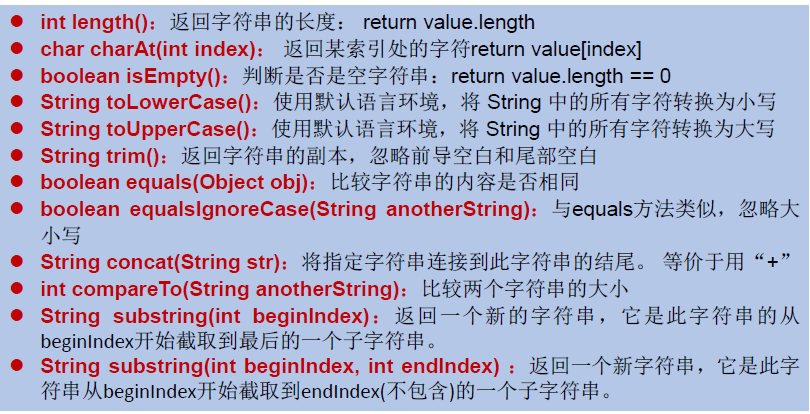
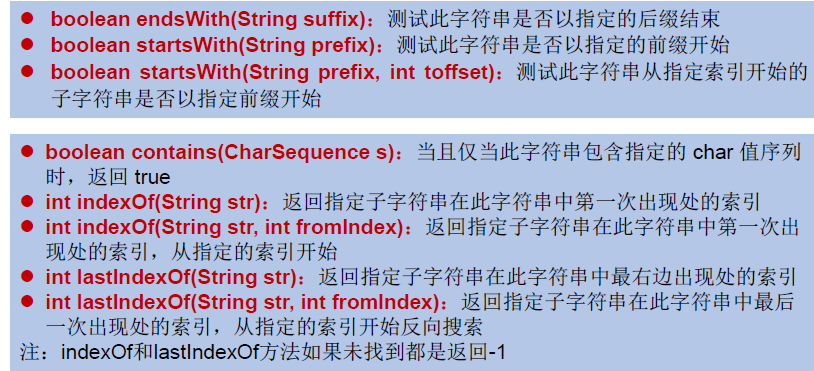
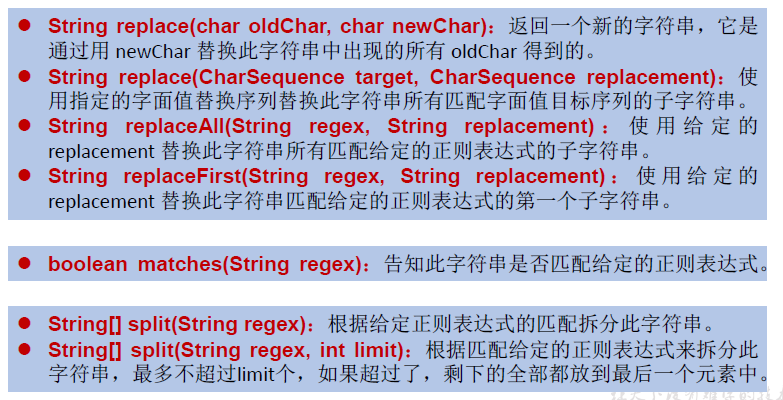
String 类与其它结构之间的转换
1、String 与基本数据类型、包装类之间的转换:
String—> 基本数据类型、包装类:调用包装类的静态方法:parseXxx(str)- 基本数据类型、包装类 —>
String:调用String重载的valueOf(xxx)
2、String 与 char[]之间的转换:
String—>char[]:调用String的toCharArray()char[]—>String:调用String的构造器
3、String 与 byte[]之间的转换
String—>byte[]:调用String的getBytes()byte[]—>String:调用String的构造器
说明:解码时,要求解码使用的字符集必须与编码时使用的字符集一致,否则会出现乱码。
【示例】
@Testpublic void test2() throws UnsupportedEncodingException {String str1 = "123";int num = Integer.parseInt(str1);String str2 = String.valueOf(num);// String str2 = num + "";String str3 = "abc123";char[] chars = str3.toCharArray();for (int i = 0; i < chars.length; i++) {System.out.println(chars[i]);}char[] arr = new char[]{'h', 'e', 'l', 'l', 'o'};String str4 = new String(arr);System.out.println(str4);String str = "abc123中国";byte[] bytes = str.getBytes();//使用默认的字符集System.out.println(Arrays.toString(bytes));//[97, 98, 99, 49, 50, 51, -28, -72, -83, -27, -101, -67]System.out.println(new String(bytes));//abc123中国byte[] bytes1 = str.getBytes("gbk");System.out.println(Arrays.toString(bytes1));//[97, 98, 99, 49, 50, 51, -42, -48, -71, -6]System.out.println(new String(bytes1, "gbk"));//abc123中国}
StringBuffer 与 StringBuilder 类
String、StringBuffer、StringBuilder三者的异同?
String:不可变的字符序列,底层使用char[]存储。StringBuffer:可变的字符序列,线程安全但是效率低,底层使用char[]存储。StringBuilder:可变的字符序列,jdk5.0新增的,线程不安全但是效率高,底层使用char[]存储。
源码分析:
String str = new String();相当于char[] value = new char[0];String str1 = new String("abc");相当于char[] value = new char[]{'a','b','c'};StringBuffer sb1 = new StringBuffer();相当于char[] value = new char[16];底层创建了一个长度是16的数组。但是执行System.out.println(sb1.length());输出结果是0而不是16,因为输出的是count值(记录有效字符的个数),不是底层value数组的长度。StringBuffer sb2 = new StringBuffer("abc");相当于char[] value = new char["abc".length() + 16];
StringBuffer / StringBuilder 扩容问题:
如果要添加的数据底层数组盛不下了,那就需要扩容底层的数组,默认情况下,扩容为原来容量的2倍 + 2,同时将原有数组中的元素复制到新的数组中。
指导意义:开发中建议大家使用:StringBuffer(int capacity) 或 StringBuilder(int capacity)
对比String、StringBuffer、StringBuilder三者的效率:
从高到低排列:StringBuilder > StringBuffer > String
StringBuffer 类中的方法
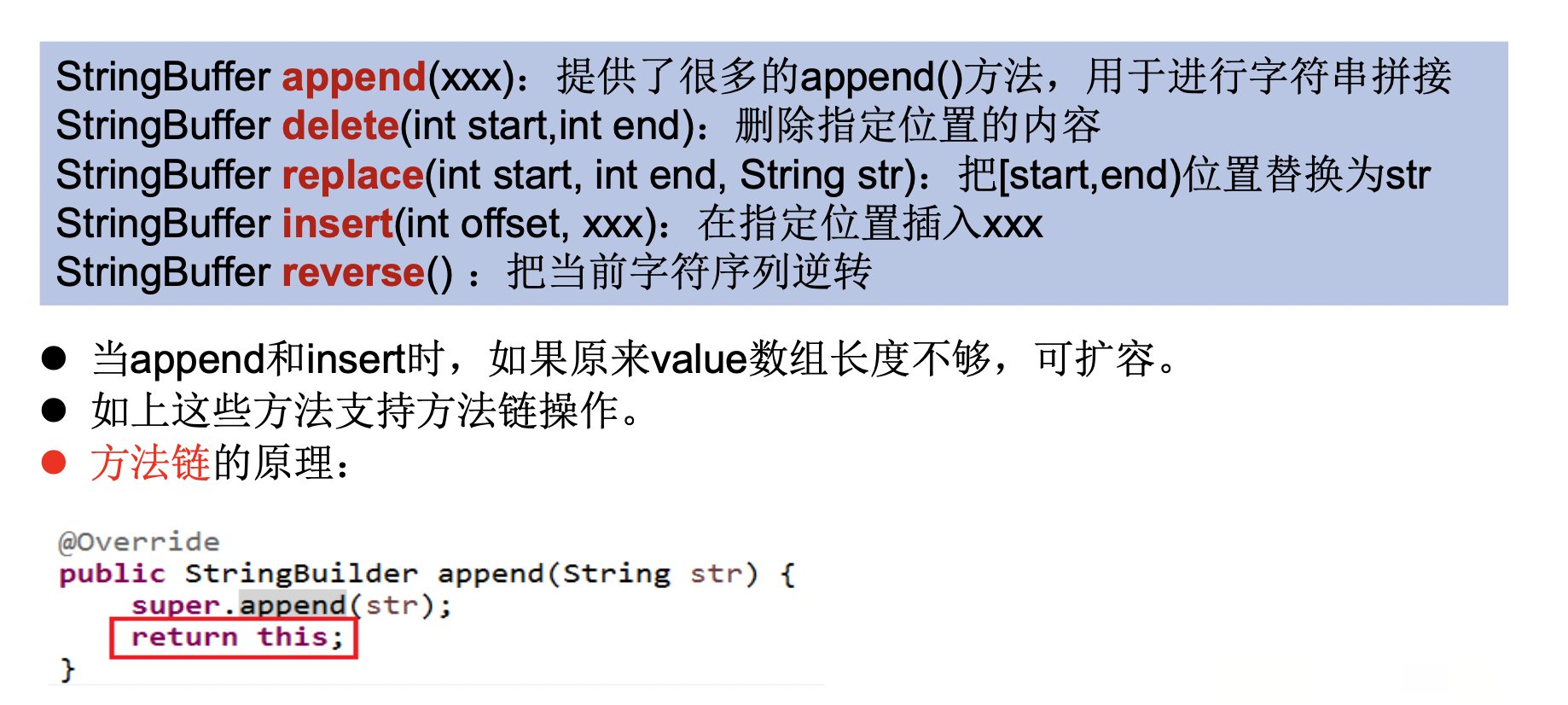

【练习题】
@Testpublic void test4() {String str = null;StringBuffer sb = new StringBuffer();sb.append(str);System.out.println(sb.length());//4System.out.println(sb);//"null"StringBuffer stringBuffer = new StringBuffer(str);//异常System.out.println(stringBuffer);}
JDK 8 之前的日期时间 API
1、java.lang.System 类
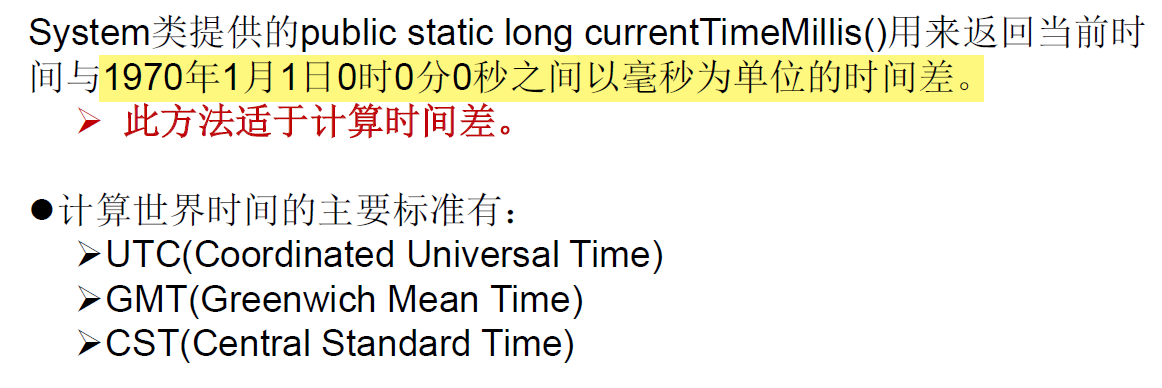
【示例】
public class DateTimeTest {/*System类中的currentTimeMillis()*/@Testpublic void test1() {long time = System.currentTimeMillis();//返回当前时间与1970年1月1日0时0分0秒之间以毫秒为单位的时间差。//称为时间戳System.out.println(time);//1631501821547}}
2、java.util.Date 类
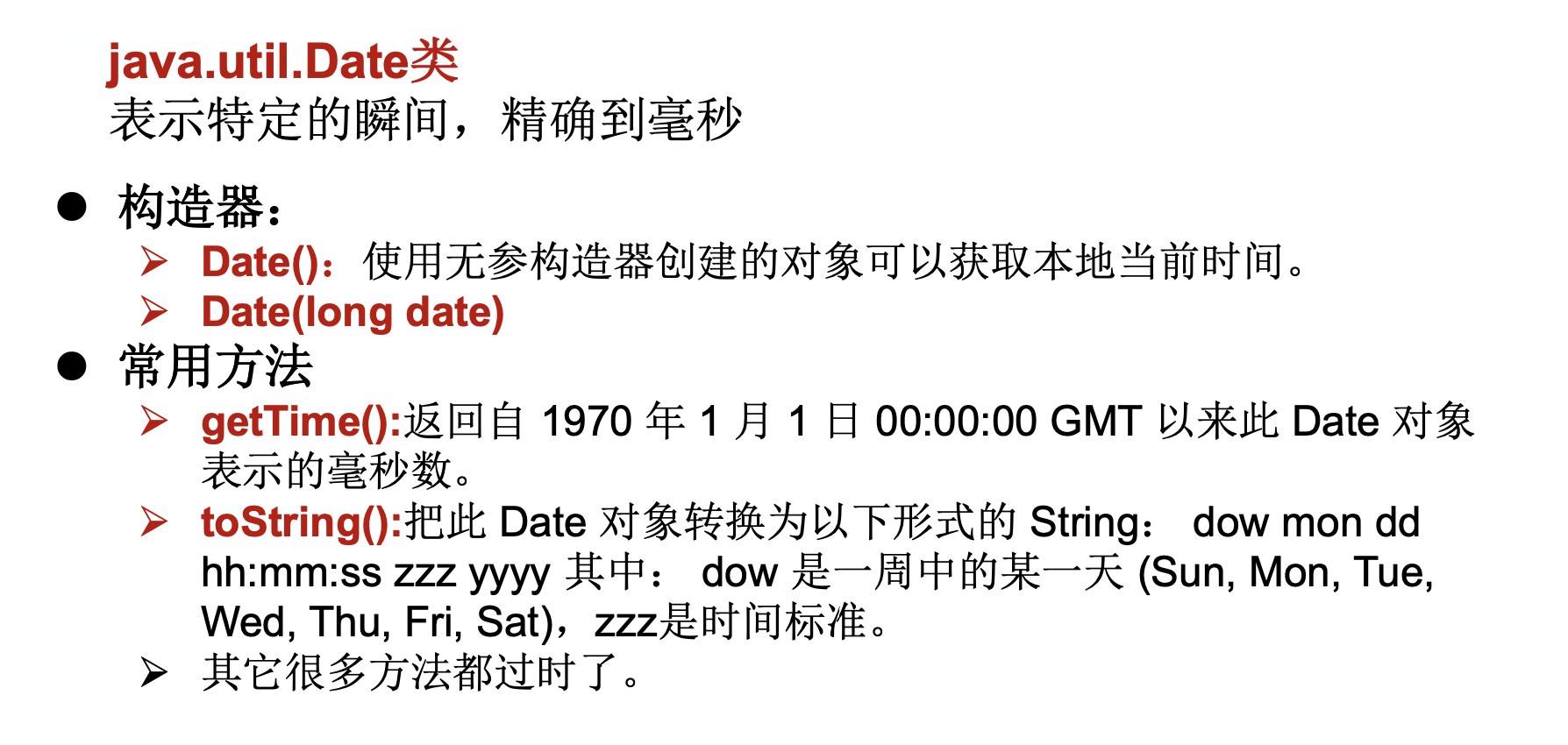
【示例】
public class DateTimeTest {/*java.util.Date类1.两个构造器的使用>构造器一:Date():创建一个对应当前时间的Date对象>构造器二:创建指定毫秒数的Date对象2.两个方法的使用>toString():显示当前的年、月、日、时、分、秒>getTime():获取当前Date对象对应的毫秒数。(时间戳)java.sql.Date类对应着数据库中的日期类型的变量,是java.util.Date类的子类>如何实例化>如何将java.util.Date对象转换为java.sql.Date对象*/@Testpublic void test2() {Date date1 = new Date();//util.DateSystem.out.println(date1);//Mon Sep 13 10:59:20 CST 2021long time = date1.getTime();System.out.println(time);//1631501960859Date date2 = new Date(1124323483859L);System.out.println(date2);//Thu Aug 18 08:04:43 CST 2005java.sql.Date date3 = new java.sql.Date(1782649582379L);System.out.println(date3);//2026-06-28//将java.util.Date对象转换为java.sql.Date对象//情况一:// Date date4 = new java.sql.Date(1782649582379L);// java.sql.Date date5 = (java.sql.Date) date4;//情况二:Date date6 = new Date();java.sql.Date date7 = new java.sql.Date(date6.getTime());System.out.println(date7);//2021-09-13}}
3、java.text.SimpleDateFormat 类
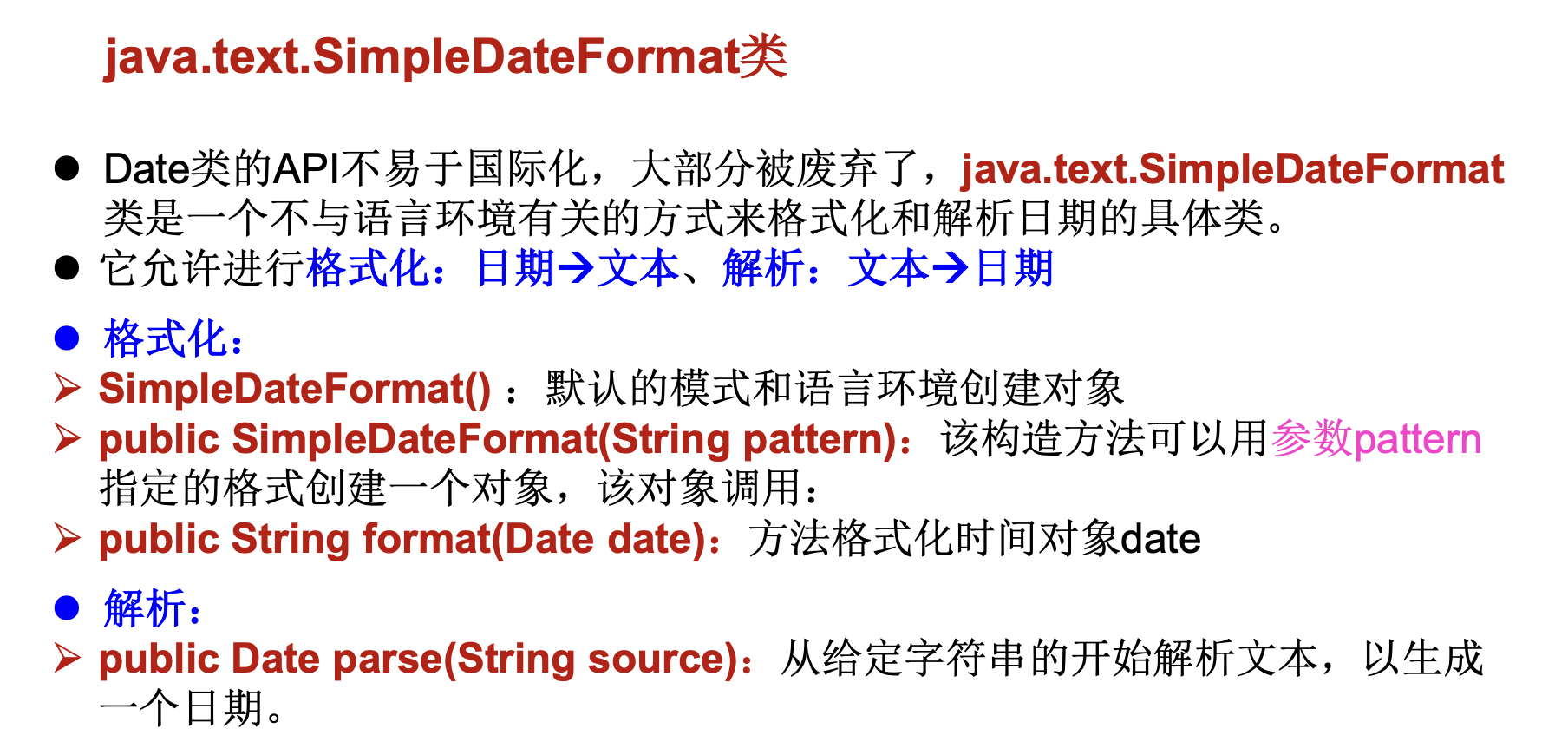
【注意】
实例化SimpleDateFormat的时候可以用默认的构造器,也可以使用带参数的构造器,按照指定的方式格式化和解析。
public class DateTimeTest {/*SimpleDateFormat的使用:SimpleDateFormat对日期Date类的格式化和解析1.两个操作:1.1 格式化:日期 --->字符串1.2 解析:格式化的逆过程,字符串 ---> 日期2.SimpleDateFormat的实例化*/@Testpublic void test3() throws ParseException {//实例化SimpleDateFormat:使用默认的构造器SimpleDateFormat sdf = new SimpleDateFormat();//格式化:日期 --->字符串Date date = new Date();String format = sdf.format(date);System.out.println(format);//21-9-13 上午11:32//解析:格式化的逆过程,字符串 ---> 日期String str = "20-1-1 上午10:10";Date date1 = sdf.parse(str);System.out.println(date1);//Wed Jan 01 10:10:00 CST 2020//按照指定的方式格式化和解析:调用带参的构造器SimpleDateFormat sdf1 = new SimpleDateFormat("yyyy-MM-dd HH:mm:ss");String format1 = sdf1.format(date);System.out.println(format1);//2021-09-13 11:37:49//解析,要求字符串必须是符合SimpleDateFormat识别的格式(通过构造器参数体现)Date date3 = sdf1.parse("2021-09-13 11:37:49");System.out.println(date3);//Mon Sep 13 11:37:49 CST 2021}}
【练习】怎么讲字符串“2020-11-09”转化为java.sql.Date类型?
@Testpublic void test0() throws ParseException {String birthday = "2020-09-08";SimpleDateFormat sdf = new SimpleDateFormat("yyyy-MM-dd");Date date = sdf.parse(birthday);System.out.println(date);//Tue Sep 08 00:00:00 CST 2020java.sql.Date birthDate = new java.sql.Date(date.getTime());System.out.println(birthDate);//2020-09-08}
4、java.util.Calendar

【示例】
@Testpublic void test5() {//1.实例化//方式一:创建其子类(GregorianCalendar)的对象//方式二:调用其静态方法getInstance()Calendar calendar = Calendar.getInstance();System.out.println(calendar.getClass());//java.util.GregorianCalendar//2.常用方法//get()int days = calendar.get(Calendar.DAY_OF_MONTH);System.out.println(days);//9System.out.println(calendar.get(Calendar.DAY_OF_YEAR));//314//set()//calendar可变性calendar.set(Calendar.DAY_OF_MONTH, 22);days = calendar.get(Calendar.DAY_OF_MONTH);System.out.println(days);//22//add()calendar.add(Calendar.DAY_OF_MONTH, -3);days = calendar.get(Calendar.DAY_OF_MONTH);System.out.println(days);//19//getTime():日历类-->DateDate date = calendar.getTime();System.out.println(date);//Thu Nov 19 12:47:04 CST 2020//setTime():Date ---> 日历类calendar.setTime(date);days = calendar.get(Calendar.DAY_OF_MONTH);System.out.println(days);//19}
JDK 8 以后的日期时间 API
提出背景
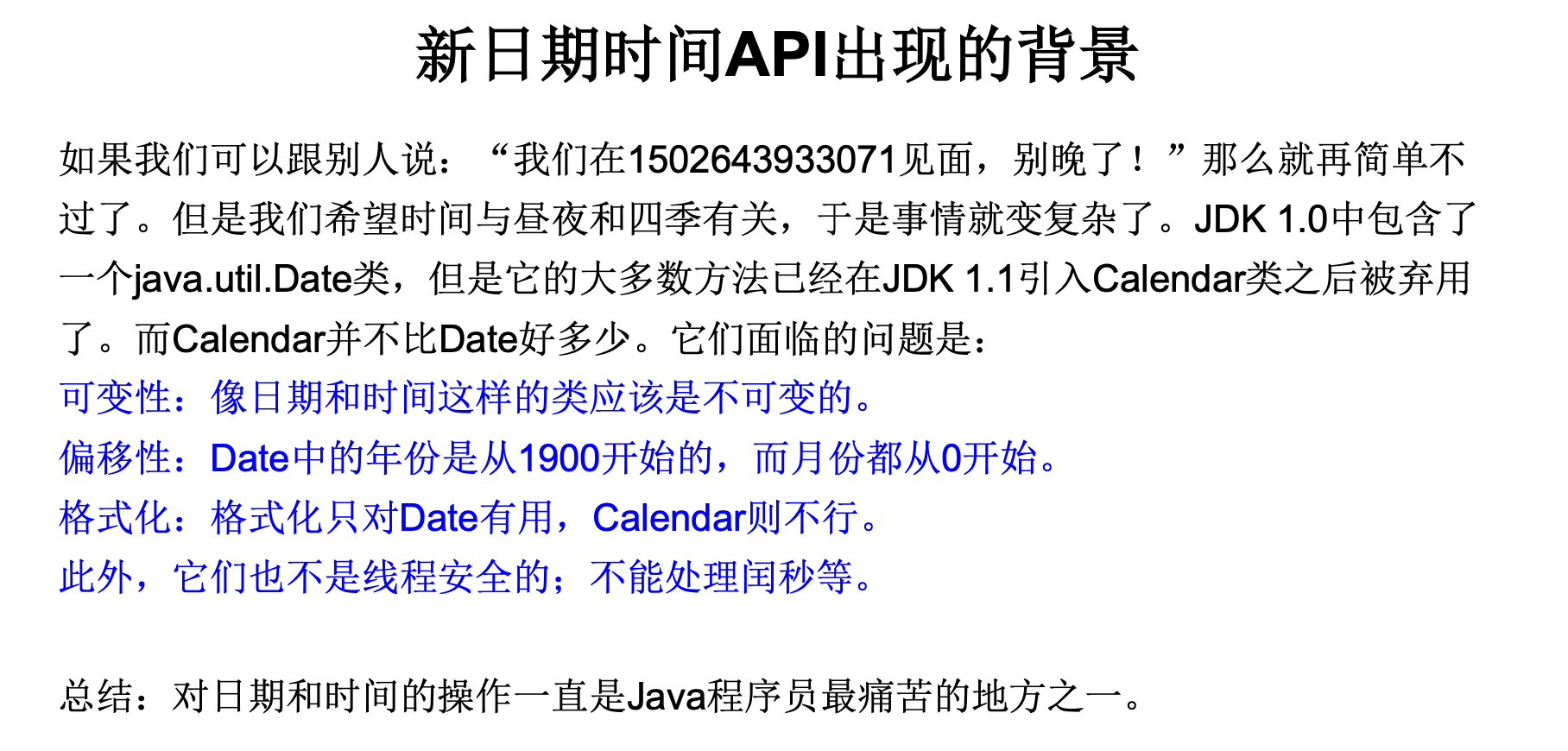
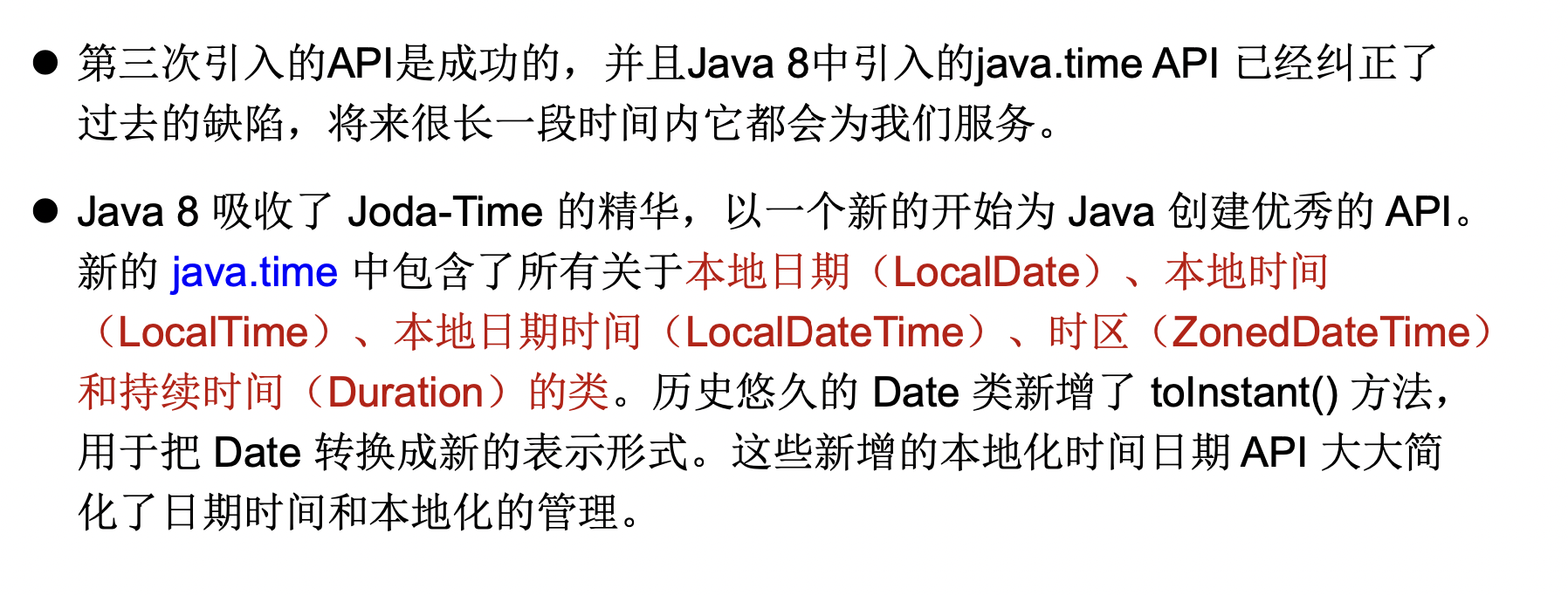
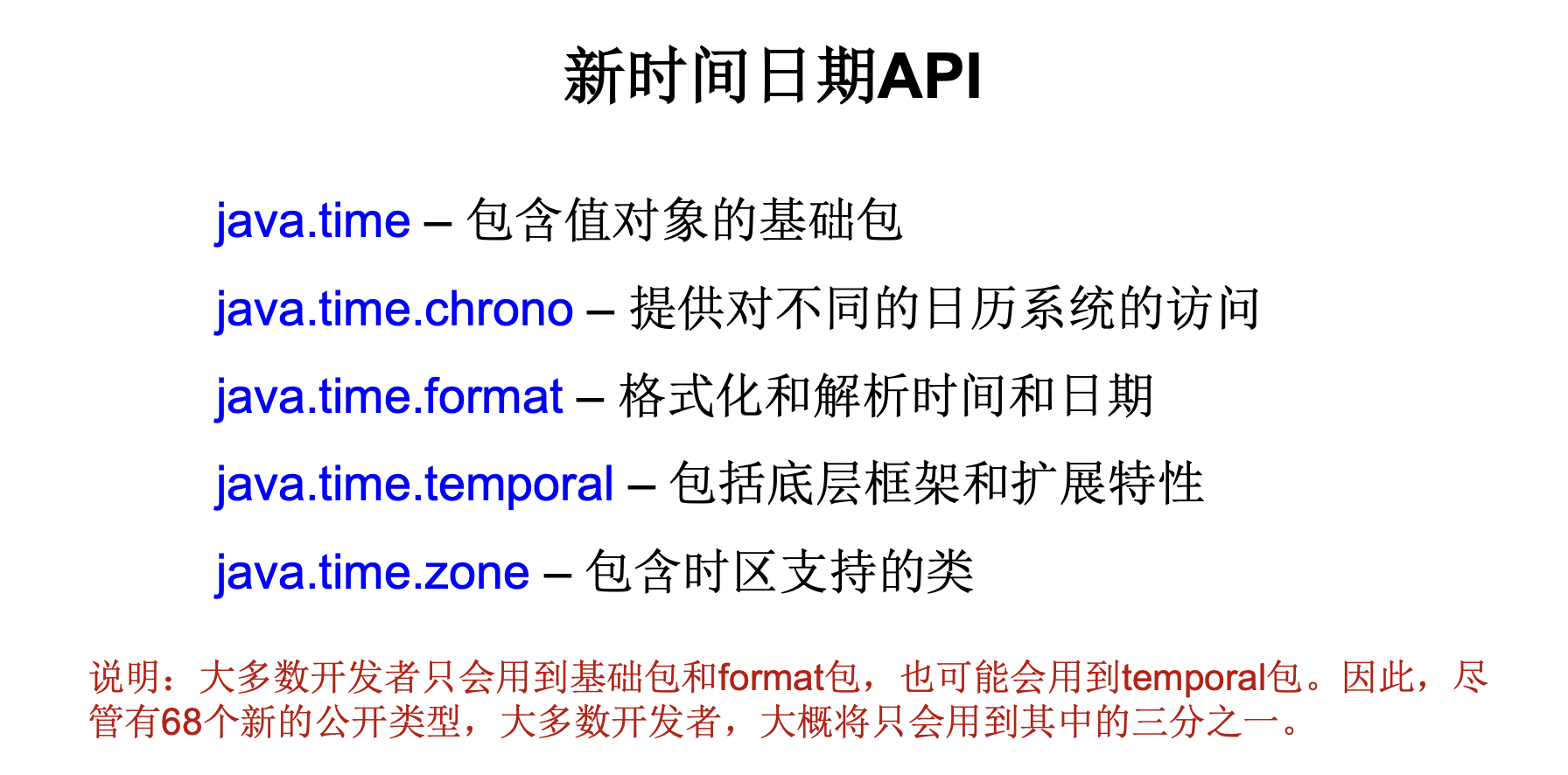
//偏移量测试@Testpublic void test1() {Date date1 = new Date(2020 - 1900, 11 - 1, 9);System.out.println(date1);//Mon Nov 09 00:00:00 CST 2020}
1、java.time.LocalDateTime
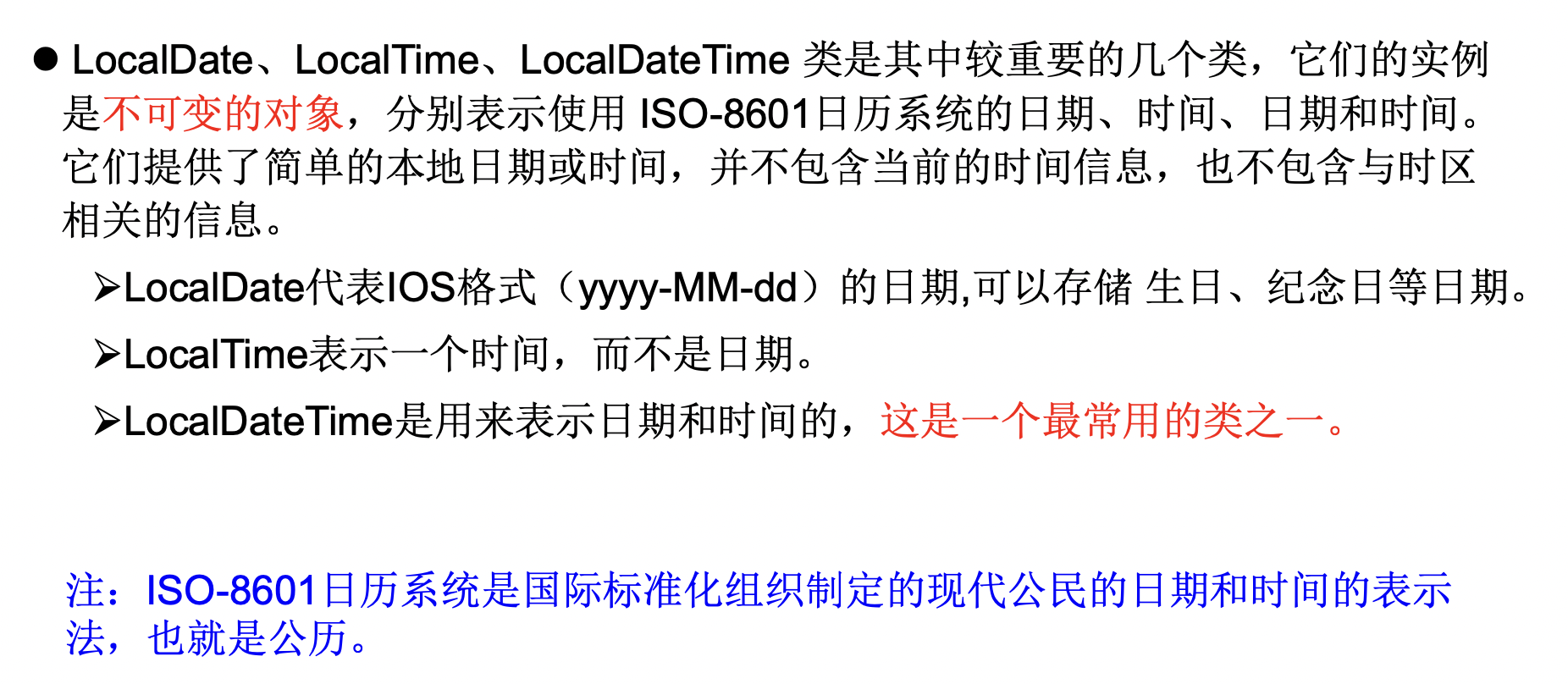
注意:有点类似于Calendar的使用,但是不可变。
【常用方法】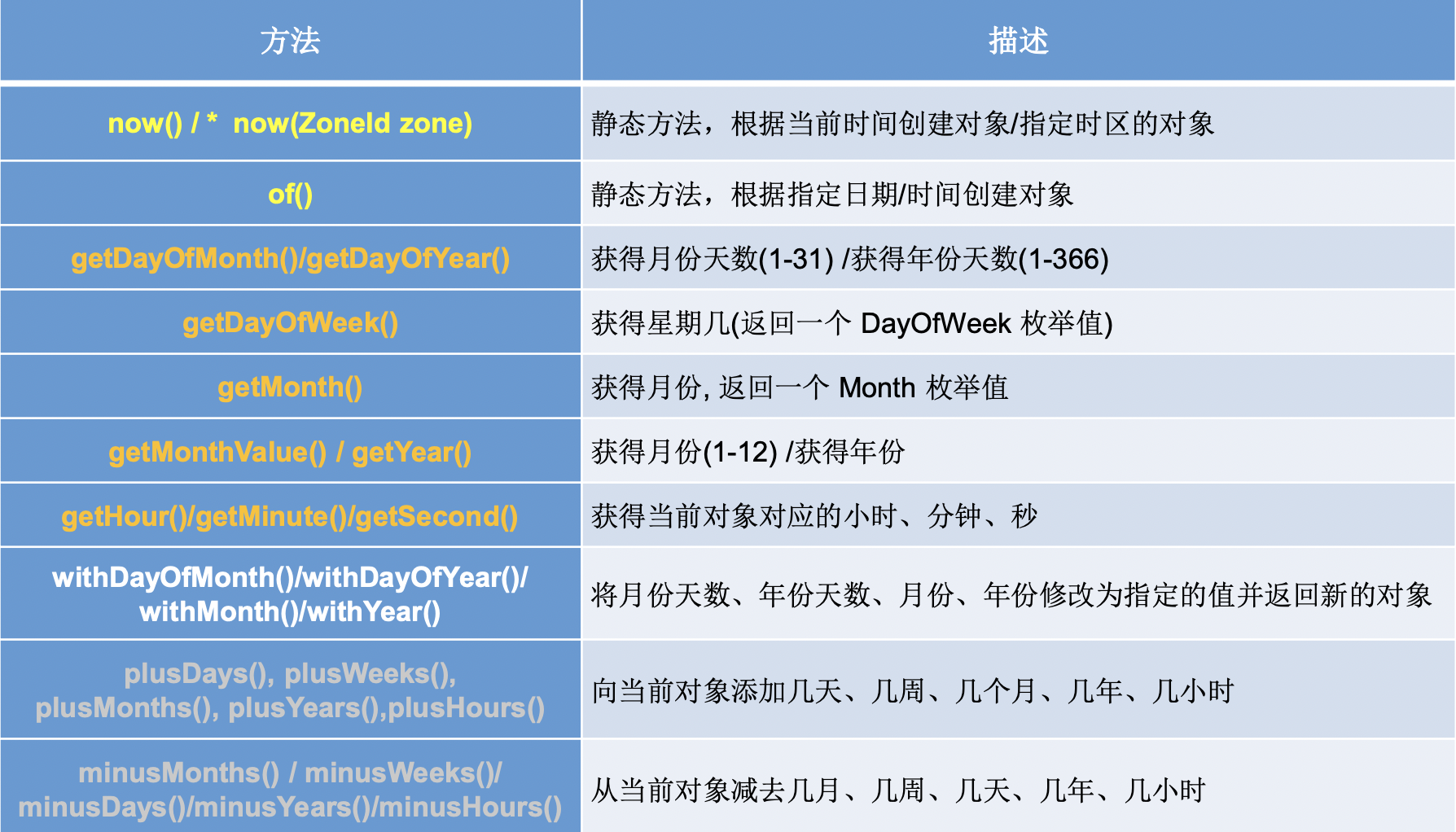
【示例】
public class DateTimeTest {/*LocalDate、LocalTime、LocalDateTime 的使用说明:1.LocalDateTime相较于LocalDate、LocalTime,使用频率要高2.类似于Calendar*/@Testpublic void test5() {//now():获取当前的日期、时间、日期+时间LocalDate date = LocalDate.now();LocalTime time = LocalTime.now();LocalDateTime dateTime = LocalDateTime.now();System.out.println(date);//2021-09-13System.out.println(time);//12:08:49.197System.out.println(dateTime);//2021-09-13T12:08:49.197//of():设置指定的年、月、日、时、分、秒。没有偏移量LocalDateTime localDateTime = LocalDateTime.of(2020, 10, 6, 13, 23, 39);System.out.println(localDateTime);//2020-10-06T13:23:39//getXxx():获取相关的属性System.out.println(dateTime.getMonthValue());//9System.out.println(dateTime.getDayOfWeek());//MONDAY//withXxx():设置相关的属性,体现不可变性LocalDate localDate = date.withDayOfMonth(22);System.out.println(date);//2021-09-13System.out.println(localDate);//2021-09-22}}
2、java.time.Instant
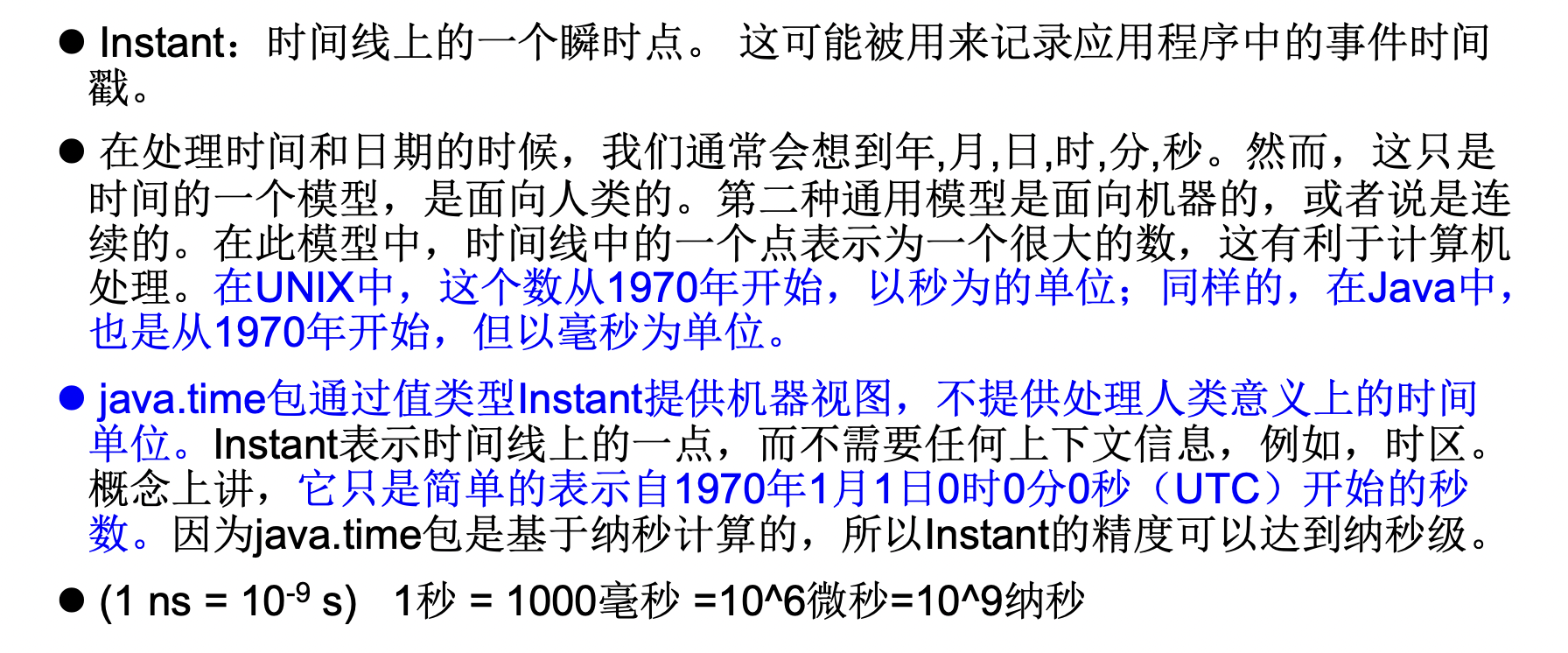
注意:java.time.Instant有点类似于java.util.Date
【常用方法】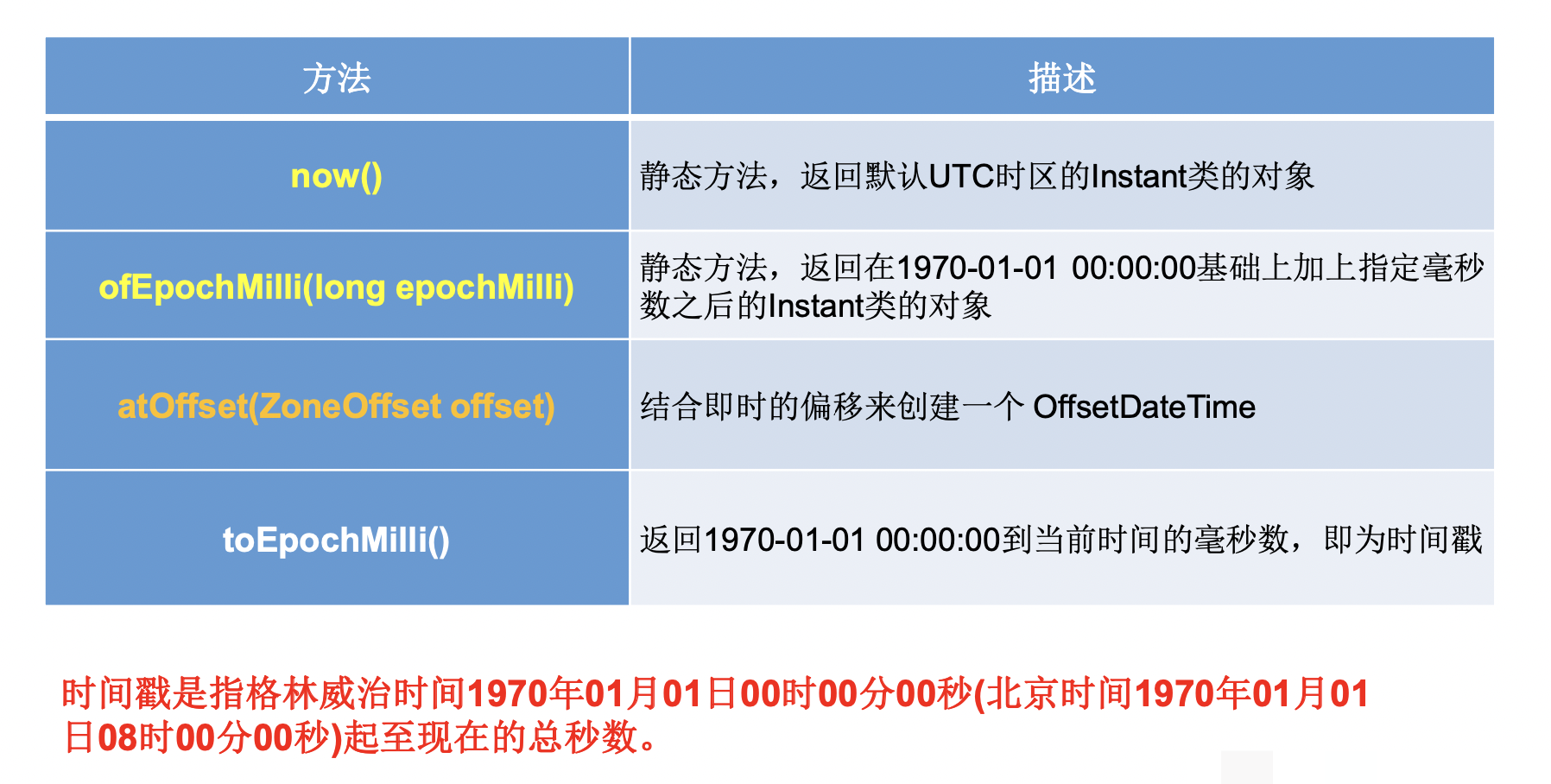
【示例】
public class DateTimeTest {/*Instant的使用类似于 java.util.Date类*/@Testpublic void test6() {//now():获取本初子午线对应的标准时间Instant instant = Instant.now();System.out.println(instant);//2021-09-13T04:21:00.425Z//添加时间的偏移量OffsetDateTime offsetDateTime = instant.atOffset(ZoneOffset.ofHours(8));System.out.println(offsetDateTime);//2021-09-13T12:21:00.425+08:00//toEpochMilli():获取自1970年1月1日0时0分0秒(UTC)开始的毫秒数 ---> Date类的getTime()System.out.println(instant.toEpochMilli());//1631506948045//ofEpochMilli():通过给定的毫秒数,获取Instant实例 -->Date(long millis)Instant instant1 = Instant.ofEpochMilli(1631506948045L);System.out.println(instant1);//2021-09-13T04:22:28.045Z}}
3、DateTimeFormatter
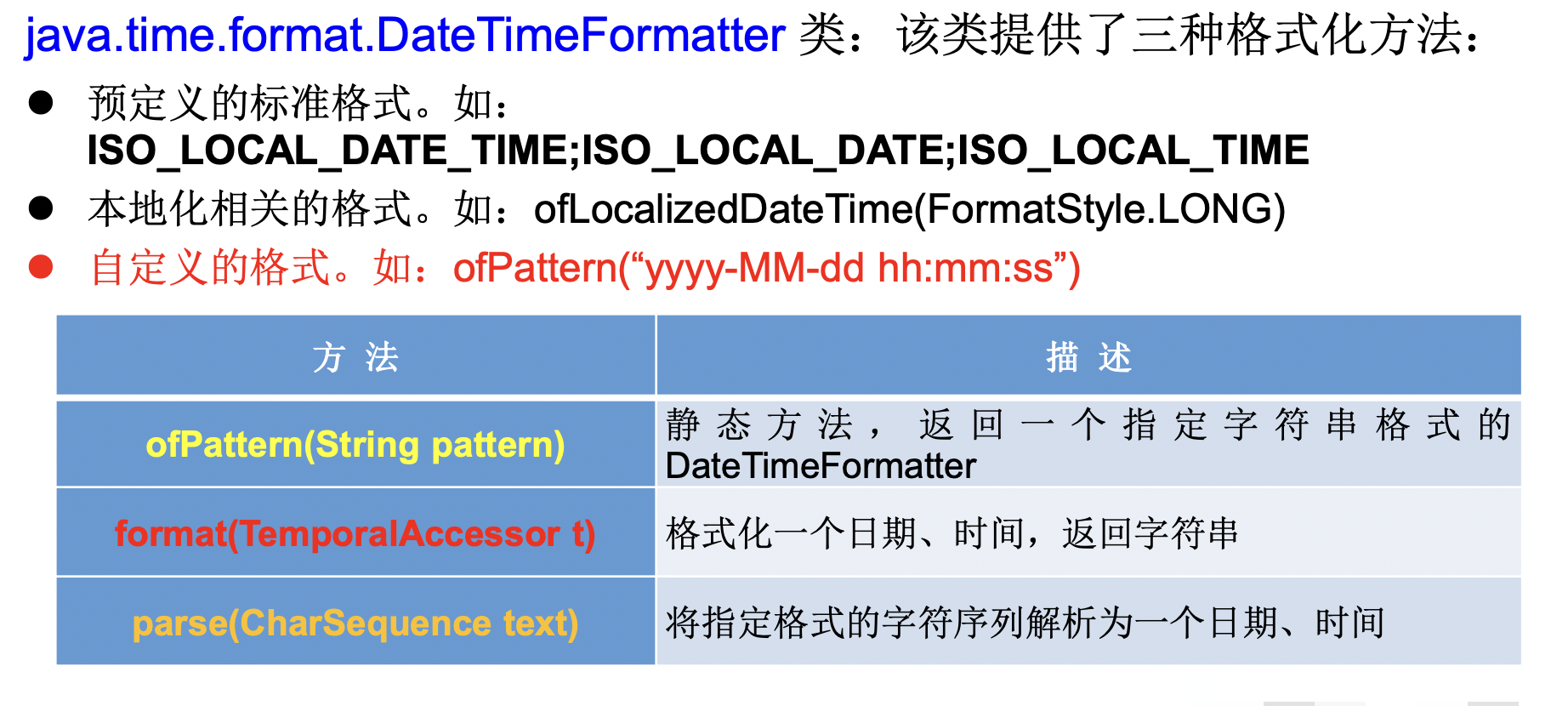
注意:java.time.format.DateTimeFormatter有点儿类似于java.text.SimpleDateFormat
【示例】
public class DateTimeTest {/*DateTimeFormatter:格式化或解析日期、时间类似于SimpleDateFormat*/@Testpublic void test7() {//方式一:预定义的标准格式。如:ISO_LOCAL_DATE_TIMEDateTimeFormatter formatter = DateTimeFormatter.ISO_LOCAL_DATE_TIME;////格式化:日期-->字符串String format = formatter.format(LocalDateTime.now());System.out.println(format);//2021-09-13T12:27:56.907//解析:字符串 -->日期TemporalAccessor parse = formatter.parse("2021-09-13T12:27:56.907");System.out.println(parse);//{},ISO resolved to 2021-09-13T12:27:56.907//方式二:本地化相关的格式。如:ofLocalizedDateTime()、ofLocalizedDate()DateTimeFormatter formatter1 = DateTimeFormatter.ofLocalizedDateTime(FormatStyle.LONG);String format1 = formatter1.format(LocalDateTime.now());System.out.println(format1);//2021年9月13日 下午12时31分38秒//(重点)方式三:自定义的格式。如:ofPattern(“yyyy-MM-dd hh:mm:ss”)DateTimeFormatter formatter2 = DateTimeFormatter.ofPattern("yyy-MM-dd HH:mm:ss");String format2 = formatter2.format(LocalDateTime.now());System.out.println(format2);//2021-09-13 12:33:22//解析TemporalAccessor parse1 = formatter2.parse("2021-09-13 12:33:22");System.out.println(parse1);//{},ISO resolved to 2021-09-13T12:33:22}}
4、其它
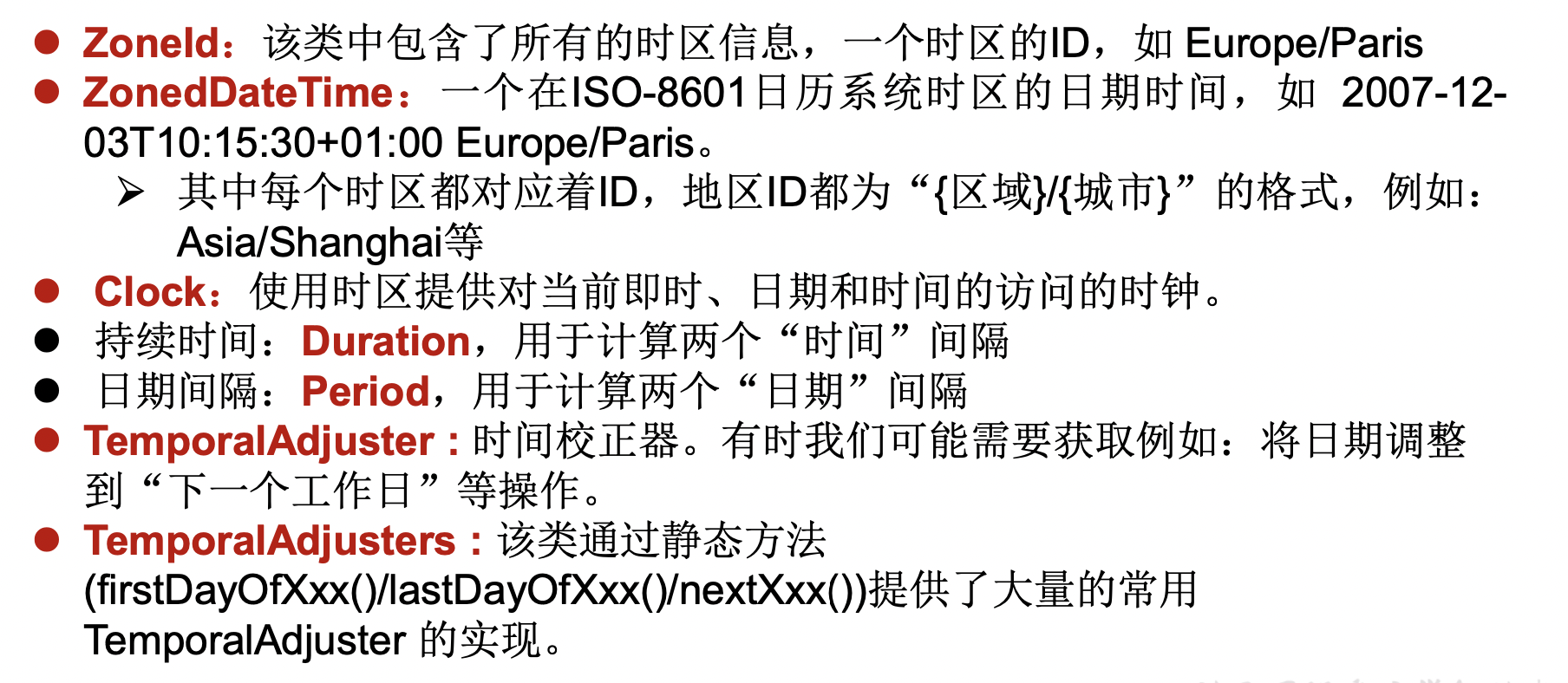
Java比较器
Java中的对象,正常情况下,只能进行比较:== 或 !=,不能使用 > 或 < 的。
但是在开发场景中,我们需要对多个对象进行排序,言外之意,就需要比较对象的大小。如何实现?使用两个接口中的任何一个:Comparable 或 Comparator。
Comparable 接口与 Comparator 的使用的对比:
Comparable接口属于自然排序,一旦确定,Comparable接口实现类的对象在任何位置都可以比较大小。Comparator接口属于定制排序,属于临时性的比较。
Comparable 接口
1、像String、包装类等实现了Comparable接口,重写了compareTo()方法,给出了比较两个对象大小的方式,并且默认从小到大排列。
2、重写compareTo(obj)的规则:
- 如果当前对象this大于形参对象obj,则返回正整数;
- 如果当前对象this小于形参对象obj,则返回负整数;
- 如果当前对象this等于形参对象obj,则返回零。
3、对于自定义类来说,如果需要排序,我们可以让自定义类实现Comparable接口,重写compareTo(obj)方法。 在compareTo(obj)方法中指明如何排序。
Comparator接口
1、背景:
当元素的类型没有实现java.lang.Comparable接口而又不方便修改代码, 或者实现了java.lang.Comparable接口的排序规则不适合当前的操作,那么可以考虑使用 Comparator 的对象来排序。
2、重写compare(Object o1, Object o2)方法,比较o1和o2的大小:
- 如果方法返回正整数,则表示o1大于o2;
- 如果返回0,表示相等;
- 返回负整数,表示o1小于o2。
【示例代码】
public class CompareTest {@Testpublic void test1() {String[] arr = new String[]{"dd", "bb", "aa", "cc"};Arrays.sort(arr);System.out.println(Arrays.toString(arr));//[aa, bb, cc, dd]}@Testpublic void test2() {Goods[] arr = new Goods[5];arr[0] = new Goods("lenovoMouse",34);arr[1] = new Goods("dellMouse",43);arr[2] = new Goods("xiaomiMouse",12);arr[3] = new Goods("huaweiMouse",65);arr[4] = new Goods("microsoftMouse",43);Arrays.sort(arr);System.out.println(Arrays.toString(arr));}@Testpublic void test3() {String[] arr = new String[]{"CC", "DD", "AA", "BB"};Arrays.sort(arr, new Comparator() {//按照字符串从大到小的顺序排列@Overridepublic int compare(Object o1, Object o2) {if (o1 instanceof String && o2 instanceof String) {String s1 = (String) o1;String s2 = (String) o2;return -s1.compareTo(s2);}throw new RuntimeException("输入的数据类型不一致");}});System.out.println(Arrays.toString(arr));//[DD, CC, BB, AA]}@Testpublic void test4() {Goods[] arr = new Goods[6];arr[0] = new Goods("lenovoMouse",34);arr[1] = new Goods("dellMouse",43);arr[2] = new Goods("xiaomiMouse",12);arr[3] = new Goods("huaweiMouse",65);arr[4] = new Goods("huaweiMouse",224);arr[5] = new Goods("microsoftMouse",43);Arrays.sort(arr, new Comparator() {@Overridepublic int compare(Object o1, Object o2) {if (o1 instanceof Goods && o2 instanceof Goods) {Goods g1 = (Goods) o1;Goods g2 = (Goods) o2;if (g1.getName().equals(g2.getName())) {return -Double.compare(g1.getPrice(), g2.getPrice());} else {return g1.getName().compareTo(g2.getName());}}throw new RuntimeException("输入的数据类型不一致");}});System.out.println(Arrays.toString(arr));}}
public class Goods implements Comparable {private String name;private double price;public Goods(String name, double price) {this.name = name;this.price = price;}public Goods() {}public String getName() {return name;}public void setName(String name) {this.name = name;}public double getPrice() {return price;}public void setPrice(double price) {this.price = price;}@Overridepublic String toString() {return "Goods{" +"name='" + name + '\'' +", price=" + price +'}';}//指明商品比较大小的方式:按照价格从低到高排序,再按照产品名称从高到低排序@Overridepublic int compareTo(Object o) {if (o instanceof Goods) {Goods goods = (Goods) o;if (this.price > goods.price) {return 1;} else if (this.price < goods.price) {return -1;} else {return -this.name.compareTo(goods.name);}}throw new RuntimeException("传入的数据类型不一致。");}}
其它类
java.lang.System 类
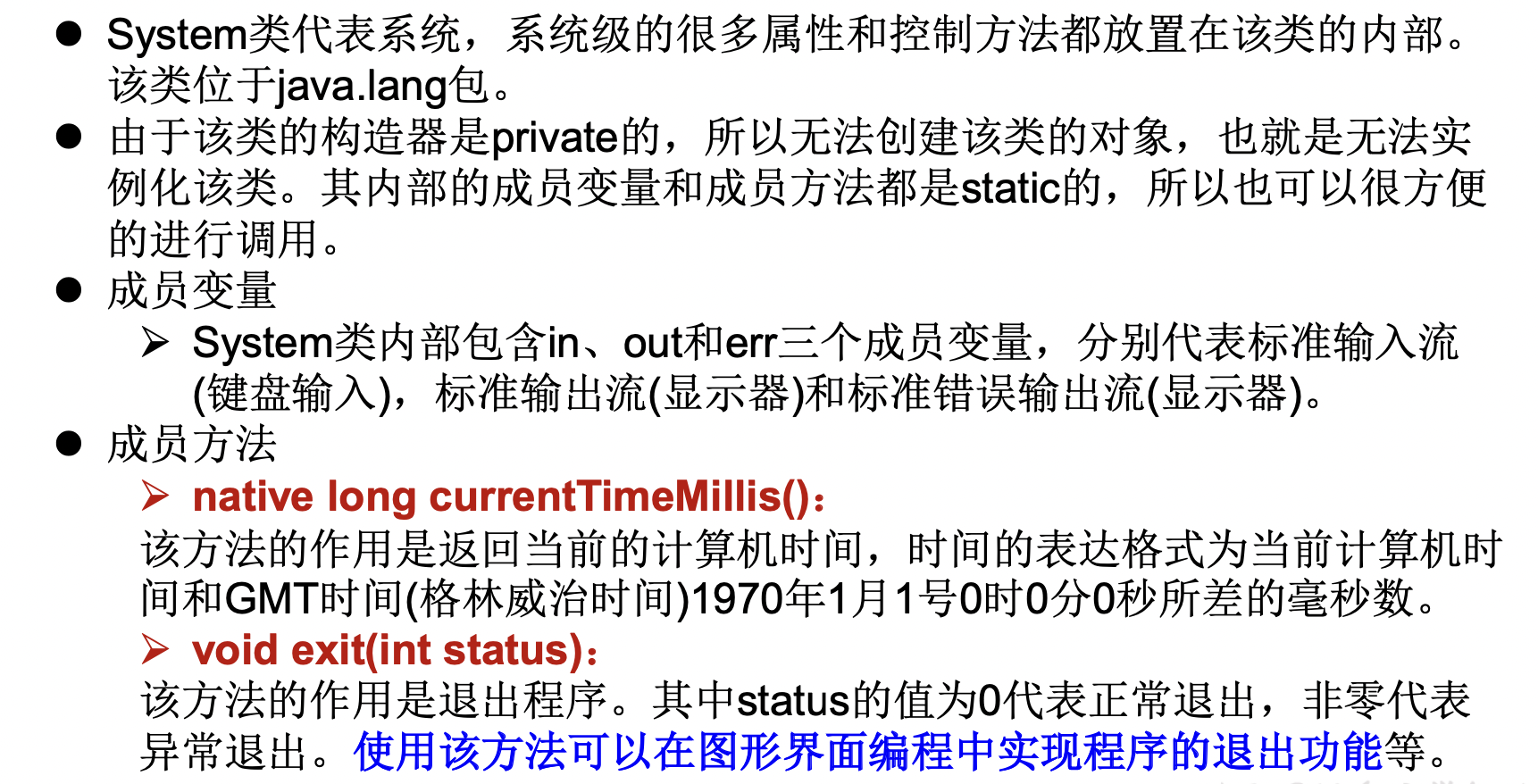
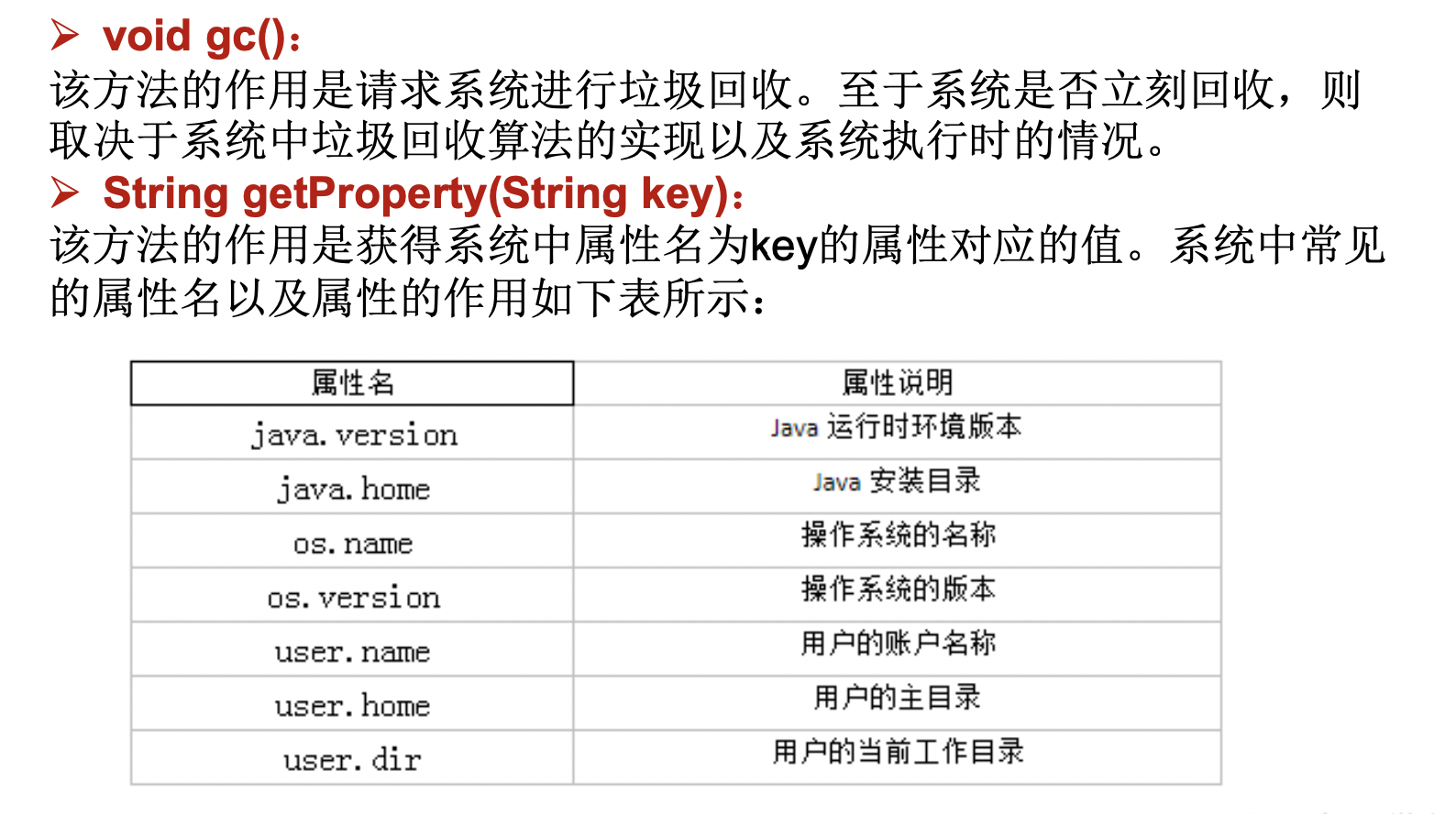
【示例代码】
public class OtherClassTest {@Testpublic void test1() {String javaVersion = System.getProperty("java.version");System.out.println("java的version:" + javaVersion);String javaHome = System.getProperty("java.home");System.out.println("java的home:" + javaHome);String osName = System.getProperty("os.name");System.out.println("os的name:" + osName);String osVersion = System.getProperty("os.version");System.out.println("os的version:" + osVersion);String userName = System.getProperty("user.name");System.out.println("user的name:" + userName);String userHome = System.getProperty("user.home");System.out.println("user的home:" + userHome);String userDir = System.getProperty("user.dir");System.out.println("user的dir:" + userDir);}
执行结果:
java.lang.Math类

BigInteger 与 BigDecimal 类
